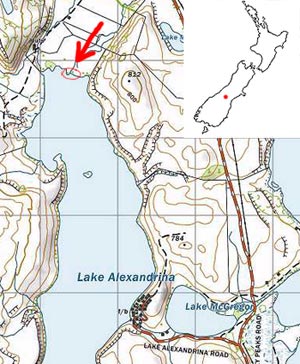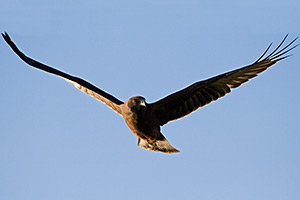Elkeith.com > Elkeith Photography > Articles > Photo Essays > "Reclusive Rail"
Photo Essay - "Reclusive Rail"

"Reclusive Rail" - one of my favourite photos from my three days with the marsh crakes
Marsh Crake are one of those many birds that most people have never even heard about, let alone seen. They live in places people never visit and like most wetland birds they are extremely shy and keep to themselves. In February 2008, having seen them for the first time only two months prior, I set about trying to photograph them.

This is where there are good numbers of marsh crake.
In the literature they are recorded as secretive and difficult to find without the use of call recordings. Every bird watcher I spoke to about them agreed that they are a very difficult bird to see, and good, unobscured looks are very rare, so photographing them would be a challenge indeed!
In New Zealand marsh crake are widespread, in fact Rod Morris tells me that they even used to be found at little Hooper's Inlet on the Otago peninsular (although they are almost certainly not there now due to past land owners' use of the area). Historically marsh crake numbers have been under recorded due to their secretive nature and little is known about them in New Zealand. The marsh crake is a very cosmopolitan bird, being native to many countries in the world.
I'd read In Kathy Ombler's book "Where to watch birds in New Zealand", that they are recorded as having good numbers in the swampy area at the head of Lake Alexandrina where Scott's Creek feeds the lake. It is a good forty minute kayak from the carpark at the outlet to the creek. (The lake is a wildlife refuge so no motor boats are allowed).
I'd seen them there for the first time while kayaking on the lake with Elke. There was a nice little patch nearby which was suitable for a small hide, (although getting to and from the hide would be a very wet and muddy experience).
I designed and built a small dome hide from a modified beach shelter I purchased from the from the warehouse for NZ$12. It had a 1.2m square footprint, rather tight, but I figured I could sit comfortably enough in it.
Kayaking out with friends to the area, I found a suitable spot near an area where the marsh crake venture out from the cover of the reeds. After installing the hide it was left for a good while for the birds to accustom themselves to it.
The afternoon I first entered the hide was very warm. I had to wait for two and three quarter hours (somehow the hide seemed much smaller than when I tried it out back at the house) before I saw my first marsh crake. It was a wonderful moment, not only was it my first picture of a marsh crake, but I finally knew that all this effort wasn't going to be a complete waste of time. I photographed them a lot that afternoon, although the light was quite dim and I new I wouldn't be able to use many of the shots.
I intended on getting to the hide before the sun came up the next morning and to be in place, ready to photograph the marsh crake in the early morning light. Kayaking out over the glassy, misty lake before dawn was reward enough, but when I arrived at the hide there were already two marsh crake just meters from the hide! (The most I saw was three at one time in that area). Strangely, they seemed unphased as I carefully entered the hide.
The morning light wasn't about to fall on my little patch for quite a while due to the tree cover, so most of the photos I took in the early part of the morning weren't very good. The marsh crake did however come up to about two meters from me (well inside the four meter minimum focusing distance of my lens). At that range you really do get to experience special moments, I at one point saw and heard one of the marsh crakes sneeze! They sent their morning feeding on small insects on the surface of the water, but I did see them catch a few little fish as well.

A Marsh Crake appears for the first time!

Pukeko chick closely following its parent.

The Australasian Shoveller that came up to the hide.

A Pukeko parent walks through in front of the hide.

The Australasian Harrier which repeatedly made the Marsh
Crake retreat out of view.
Below are some extracts from my notebook, it can be a long time between interesting events, eventually you start to get rather excited about very little!
January 6th 2008
17:00 - Entered hide- very warm and humid
17:05 - Opened rear zip for ventilation
17:34 - Banana time
17:45 - Harrier flew over, seat getting rather uncomfortable
17:51 - Found that if I bend over double I can fully extend my legs
18:30 - All food finished, stripped down to underwear due to heat
19:07 - Do marsh crake make pukeko noises?
19:27 - Pukeko with two chicks came through my patch
19:46 - Marsh Crake!!! - only for 30 secs though
19:51 - Just as the marsh crake poked his beak out briefly a harrier flew over head scaring him off
19:55 - The harrier got something. Did the harrier eat my marsh crake?
19:59 - Marshy came back
20:20 - He's spending most of this time in a spot where he is obscured
20:26 - Sun set behind the hills - pack up time
January 7th 2008
7:30 - One was in front of hide as I arrived - stayed while I set up, low light levels though.
7:54 - MC came out of hiding briefly, disappeared quickly though. Still dim conditions.
8:03 - MC walked all the way from the hide to the end of the reads 30m away, moving quite fast.
8:22 - Lots of shots 8-10m from hide, still no direct light though.
8:27 - I saw and heard him sneeze! He also stretched right up high to take an insect.
8:35 - I got a great fright when a fish jumped out of the water - didn't scare MC though.
8:47 - Marshy has a friend!
9:03 - MC caught a fish, shook it a bit before swallowing it head first.
9:53 - Time to pack up and go home.
After I had packed up my hide and was having a little scout around in my kayak before paddling home that I found a very cooperative marsh crake, he was unphased that I was there in a big yellow kayak. I followed him around for almost an hour as he ran, fished and flew on his daily business. I would have preferred a lower viewpoint, but there aren't too many options when you have expensive gear in a kayak.
Of the 200 odd photos I took over the two days, one of my other favourite shots is one of the marsh crake shaking a fish after it'd been caught. (They always seem to do this, I'm not sure if they are trying to kill it or what they are doing). Had there been a bit more light available it would have been a great photograph, as it is it really just makes me want to go out there and try again.
The photo at the top of this page was taken from the kayak during this time. I am secretly a bit annoyed that I got better shots from the kayak than I did from the hide, but I guess that's how you learn.
For those that are interested in such things, it was taken with a Canon 400D camera with a Sigma 500mm f/4.5 APO lens at 1/640th of a second at f/4.5 and ISO 200. It was taken hand held from a partially beached kayak.
In the photo the marsh crake is focusing on a small insect, and a split second later he lunged out and nabbed it. I particularly like this photo because it shows many aspects of the marsh crake's persona (at least in my mind). I love the way the light falls nicely just on the marsh crake and reveals it's amazing, and seldom seen, colours. In particular I like it's multifaceted green on the beak. The reflections on it's chest seem to give it more depth. The dark background is quite representative of it's dark home and secretive nature. I just wish there was a bit more action in the photo.
It's seldom that I sit still in the outdoors and just observe and listen. A lot happens that usually goes unnoticed. I've decided that that that is one of the best things about being in a hide, it makes you sit still. During my hours out with the marsh crakes, I learnt to notice that whenever they quickly dashed back into the reeds, that I could look up and get some photos of an Australasian Harrier flying over head. It would frequently crash land in the tree above the hide and the marsh crakes wouldn't return until it had gone. A little family of Pukeko's walked right through the area in front of the hide, (they were rather wary though). A number of different ducks came right up to the hide and at least two trout jumped in the same area.
This photo has subsequently been selected for use in Geoff Moon's latest book, "Inside New Zealand's Wetlands". It will be great to see it in print and quite a privilege that it is in one by Geoff Moon!
I plan to go out to the marsh crakes again this year once it gets a bit warmer, maybe with a floating hide, and hopefully I'll be able to get some action shots of these secretive birds.


